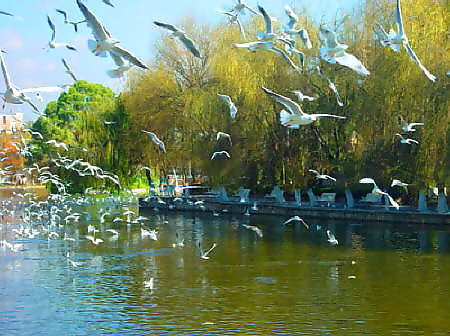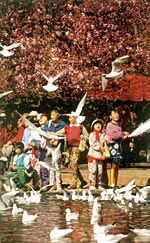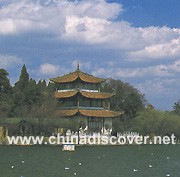Cuihu Park

Cuihu Park, covering an area of 210,000 square meters, is located in the northern part of Kunming's city proper. It was made a public park in the early 1910s.
The Cuihu Lake Park, situated at the western foot of Wuhua Hill, is a scenically beautiful park inside the city. By the end of the Yuan Dynasty, it was still a swampy field for growing vegetables, lotuses and rice, hence the name "Vegetable Lake". The water-level of Dianchi Lake was then so high that it was connected with the Cuihu Lake. That is why we have the couplet: "Dianchi Lake spreads five hundred li; the Vegetable Lake merges with it." As there were nine mouths of springs beyond the Bamboo Island in the northeast, the lake was also called "The Nine-Dragon Pond". It now covers fifteen hectares of land. Since 1985, the red-pecked seagulls from Siberia have been spending the winter months on Cuihu Lake. The entire Cuihu Park is a green world, with willow trees swaying gently on the dikes, and the surface of the lake covered all over with lotus plants. All the year round the park is the venue of one sort of exhibition or another, and with its snug seclusion it is frequented by local residents who come here for a few hours of leisure. In winter and spring, Kunming residents flock to the Cuihu Park to feed red-beaked gulls - there are tens of thousands of them, which descend upon the lake. This lovable scene, in which man, birds, and nature mingle in such harmony, has kept occurring over the last ten years. The love of the Kunming people for wildlife has added to the charms of the City of Spring.
There used to be a scenically beautiful island at the centre of the lake. In the year 1382, Mu Ying, the Garrison Commander, started building the capital of Yunnan Province in Kunming, and the Cuihu Lake was enclosed within the brick walls of the city. A military structure, called "the Liu (Willows) Barracks", was built, which was later changed into a villa for the Mu family. In 1692, Wang Jiwen, the provincial governor, built the Biyiting (literally Green Ripples Pavilion), commonly called Haixinting (a Pavilion in the Centre of the Lake). Two long banks divide the Lake into four parts. Embraced by willow trees along the banks dotted with a variety of lotuses, with the delightful contrast between the weeping willows and the lotuses, the lake offers a scene of freshness, serenity, and beauty, hence the graceful name "The Cuihu Lake". The main attractions include lotuses, fish, willow trees and pavilions. Ling Shiyi, a Cantonese in the Qing Dynasty, wrote in a couplet: Fishes teem in the ten-mu lotus pond; over half the city poplars and willows are caressing pavilions." It is a superb description of the scenery.
The Haixinting Pavilion is at the centre of the Lake. On the north and south stand imposingly two octagonal pavilions with craved beams and painted rafters and beautiful glazed tiles and elegant eaves. Inside the Haixinting there are two courtyards, where all kinds of shows are held throughout the four seasons: flower shows, lantern shows, fish shows and picture shows. Flowers and trees are growing luxuriantly in the yards. On the west of the pavilion are buildings for fish-watching. There is a two-storey pavilion on which hangs a horizontal board inscribed with four characters meaning "Drunk in spring in the abode of immortals" and facing north is a fish-watching pavilion. The lake, its banks and the pavilions are wonderfully arranged, and the painted corridor alongside the lake and the zigzag bridge are well connected. All the buildings have yellow and green glazed tile roofs, with corners seeming to fly and beams and rafters colourfully painted, typifying Chinese classical park  designs. On the Fish-Watching Pavilion there is a couplet written by Huang Kuiguang, a scholar from Fujian in the Qing Dynasty: "There stands a pavilion that flanks the lake, taking upon one tenth of its area; at leisure I'll come to drink alone under the moon and immediately become one of the three." The other two refer to the moon and his own reflection in the pond. This couplet has been chosen many times as one of the most famous couplets depicting landscapes in China.
designs. On the Fish-Watching Pavilion there is a couplet written by Huang Kuiguang, a scholar from Fujian in the Qing Dynasty: "There stands a pavilion that flanks the lake, taking upon one tenth of its area; at leisure I'll come to drink alone under the moon and immediately become one of the three." The other two refer to the moon and his own reflection in the pond. This couplet has been chosen many times as one of the most famous couplets depicting landscapes in China.
East of the pavilion there is a big tree-surrounded garden consisting of three tiny peninsulas which form a garden within the garden. In the garden Chinese flowering crabapple trees bloom like red clouds, camellias and azalea give off sweet scent and weeping willows bow gently. On the lake float small boats presenting a scene of bursting life.
On the Gourd Island in the southwest, there are rows of palm trees dotted with groves of banana herbs, under which is a carpet of green grass. The Nine-Bend Bridge zigzags in the lake. Here is an eye-catching sub-tropical scene for the tourists. On the northeastern corner is the Bamboo-Groves Island. Along the banks are bamboos and azaleas intertwined with vines. Around the Nine-Dragon Pond is a big garden, where people enjoy the potted landscape and celebrate the Spring Festival. On the Children's Playground, located on the southwestern side of the lake, the dragon rollicking in the water, the flying merry-go-round rotating in the air, and the miniature train rushing round and round give children fun and make them laugh.
Every winter, thousands of red-beaked sea gulls from the north migrate to the scenically beautiful Cuihu Lake Park. These sea gulls swooping over the water and scrambling with one another for crumbs of food make the park even more glamorous.
Early in the morning, hundreds of people, men and women, young and old, come to the banks of the lake to practice boxing, jogging, singing, and sword-dancing. It is full of life everywhere. In the evening, people come to have a stroll, to enjoy the scenery, or to chant antiphonal singing, amidst willows on the lake banks, feeling carefree and contented.





